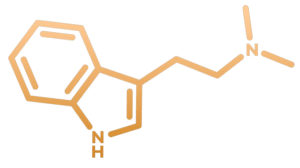What are the risks and dangers of a truffle ceremony?
Many people wonder about the dangers of a truffle ceremony. What many people ask is whether truffle ceremony would be dangerous because it could induce psychosis. Is this the case? And what other things should we look out for when someone signs up for a magic truffle ceremony with us?
What is a truffle ceremony?
During a truffle ceremony, participants consume psychedelic truffles, which naturally contain psilocybin. This substance is converted in the body into psilocin, which activates serotonin receptors in the brain. The effect can lead to changes in perception, mood and consciousness. Despite the intense experiences, several sources indicate that - given proper preparation and guidance - there are relatively few risks associated with using these substances.
Overview of key risks
Physical complications
Although truffles are generally considered safe, they can cause temporary physical reactions, such as increased heart rate, blood pressure fluctuations, nausea or confusion. These effects are usually short-lived and disappear after a few hours, as psilocybin has an average half-life of 2.5 hours. The risk of serious physical complications is especially relevant for people with pre-existing cardiovascular diseases. Scientific literature confirms that, compared to other substances such as alcohol or XTC, the physiological impact of psilocybin is limited when used responsibly.
Psychological complications
Although psychedelics can have therapeutic effects in some cases, using truffles can worsen existing mental health conditions or even trigger new problems. People with a history of depression, anxiety disorders or bipolar disorder may be at increased risk. A thorough screening prior to the ceremony helps with this. Scientific studies, including research from institutions such as Johns Hopkins University, suggest that psilocybin - if controlled and supervised - can be safely used for specific mental disorders, but also emphasise the need to keep an extra eye on individuals with vulnerable mental health conditions.
Bad trips
A frequently mentioned risk is the possibility of a bad trip. This can occur when the setting is not safe or when a participant is not in an optimal state of mind. With a bad trip, feelings of anxiety, panic and overwhelming emotions can rear their heads. Our pre-trip screening, advice to improve neurochemistry and guidance from professionals play a crucial role in creating a familiar environment and providing the necessary support to calm negative experiences. As a result, the risk of a long-term unpleasant experience is greatly reduced.
Psychoses
Research suggests that the active ingredient in truffles, psilocybin, does not usually cause long-term psychosis in people without a psychotic predisposition. The effects of psilocybin depend heavily on the 'set and setting' - the mental state of the user and the environment in which the drug is taken. However, if someone is already prone to psychosis, the intense mind-altering experience of psilocybin can act as a catalyst for a psychotic reaction. It is therefore crucial that people who know or suspect they are psychosis-prone take extra care when using truffles and other psychedelics.
The role of professional supervisors
An important aspect of a safe truffle ceremony is the use of expert facilitators. Prior to the ceremony, there is often an extensive intake interview in which medical and psychological background is discussed. This preparation helps to identify possible risks early and, where necessary, advise against taking part. During the ceremony, an experienced team is on hand to provide support, so that even if there is a difficult experience, the participant is not alone. After the session, aftercare is often provided to ensure the insights and emotions gained are properly integrated into daily life.
Recent research supports this integration process: studies show that good counselling not only reduces the likelihood of a negative experience, but also enhances the therapeutic value of psilocybin. For example, a study published in the Journal of Psychopharmacology stresses that the set and setting - or mental state of the user and the environment - are crucial for a positive outcome in psychedelic therapy.
Our tutors
With a background in chemistry, a passion for philosophy, combined with extensive knowledge of psychology and health, his approach is holistic. Marcel is a full-time trip facilitator. With over 2200 guided sessions, Marcel has the most experience of our team.
Ronald is a psychosocial therapist and has completed the following training courses: Jungian Philosophical Therapist, Psychodrama Therapist, Master Voice Dialogue, Transformation Psychology, Internal Family System (IFS), Mindfulness and Compassion Trainer.
Janneke studies Applied Psychology, is a lifestyle coach, provides initial customer contact, draws up lifestyle plans and performs administrative tasks. She also acts as a confidential counselor. In addition to these tasks, she is available to a limited extent for coaching sessions.
Sascha has a good foundation as a psychedelic therapist with her studies in psychology, a Master's degree in Clinical Psychology and work experience in addiction care, (specialist) mental health care and rehabilitation as a psychologist. She has additional training in cognitive behavioral therapy and EMDR.
As a psychologist, Reineke combines both regular and alternative care methods to provide the best possible treatment. She uses various techniques, such as talk therapy, yoga, breathing exercises and EMDR in combination with the therapeutic effects of psychedelics.
Gijs has 20 years of experience in outpatient mental health care. He taught and supervised the MGZ-GGZ course at HAN (Arnhem Nijmegen University of Applied Sciences). Gijs has also developed extensively in mindfulness, talk therapy, neurofeedback, meditation, compassion training and ACT.
The ratio of incidents
There is a clear difference in incident frequency and severity when comparing truffles (psilocybin-containing toads or truffles) with many other substances. Studies and expert evaluations show that incidents with truffles are very rare. For instance, it is estimated that there is only about 1 incident per 50,000 users, and that - provided they are used in a controlled and properly supervised setting - the risks of a truffle experience are generally low.
Alcohol versus truffles
Alcohol is one of the most incident and harmful substances in our society. According to the RIVM, alcohol and tobacco score very high on the scale of total harmfulness at both individual and population levels. This is due to their high frequency of use, risks to driving, aggression, chronic diseases and numerous traffic and health incidents. In comparison, incidents involving truffles are exceptionally rare and mostly mild, especially when attention is paid to a safe "set and setting".
Ayahuasca versus truffles
Ayahuasca is also a natural psychedelic substance, but the risks are different. The effects of ayahuasca can be intense and unpredictable, especially when used without adequate supervision or in combination with certain medications (such as antidepressants or antipsychotics). In ayahuasca ceremonies, severe psychological reactions - such as the stirring up of trauma or even the triggering of psychosis - sometimes occur, which can increase the risks for vulnerable people. Nevertheless, even with ayahuasca experiences, incidents are reported relatively rarely, provided they take place in a controlled setting.

Truffles compared to other drugs
Other substances such as speed, ecstasy or ketamine each have their own risk profiles. These substances can lead to unpredictable reactions, higher addiction rates, or more pronounced physical and psychological side effects - especially when used on the nightlife scene or in unsafe settings. By comparison, truffles tend to be less risky. Research suggests that, when used responsibly (e.g. during a ceremony with professional supervision), truffles have a low incident risk and are less likely to cause long-term harm or addiction.
Summary
- Truffles: Incidents are very rare (about 1 in 50,000), especially when properly prepared and supervised.
- Alcohol: Has a much higher incident and harm rate, with numerous health and traffic incidents due to high frequency of use and misuse.
- Ayahuasca: Can be riskier in unsafe or careless conditions, especially for people with underlying mental vulnerabilities, but in controlled settings, incidents are also relatively rare.
- Other drugs: Drugs like speed, ecstasy and ketamine often have a higher risk profile in terms of unpredictable effects, addiction and physical side effects.
Due to the low incidence of adverse events with truffles - compared to the high incidence with alcohol and the potentially more intense reactions with ayahuasca and some other drugs - it is still important that screening, preparation and professional counselling are crucial for minimising risks when using psychedelics and at truffle ceremonies.
Finally
While a truffle ceremony offers great potential for personal and spiritual growth, it is important to be aware of the risks. The main dangers - such as the risk of a bad trip, psychological complications and temporary physical reactions - can be significantly reduced by choosing a professional and safe setting. Scientific studies confirm that, when psilocybin is used carefully and under supervision, the risks are limited and the therapeutic benefits are evident.
For anyone considering participating in a truffle ceremony, it is essential to be well-informed and only choose an environment where safety and care are paramount. You can read more about a truffle ceremony, fill in the application or check the available dates via the buttons.
Frequently asked questions
The most frequently asked questions about session with psilocybin
View the answers to the most frequently asked questions about ceremonies with truffles and psilocybin here. Is the answer not here? You can also ask your questions to our chatbot Trippy or contact us.
Psilocybin truffles - also known as magic truffles - are underground, hard tubers (sclerotia) produced by certain species of psychedelic fungi. They contain the active substance psilocybin, which is converted into psilocin in the body. This substance causes the psychedelic effects, such as changes in perception, mood and consciousness.
Unlike traditional magic mushrooms (the fruiting bodies of the fungus), psilocybin truffles are legally available in the Netherlands and are often used in controlled and supervised settings, for example in ceremonial or therapeutic contexts. The experience with truffles is highly dependent on the "set and setting", or state of mind of the user and the environment in which the truffles are taken.
In summary, psilocybin truffles are a natural source of the psychedelic substance psilocybin, which causes an altered state of consciousness and is often used for spiritual, therapeutic or recreational purposes.
During a truffle ceremony, the participant goes through a carefully guided, phased inner journey that can be both physically and emotionally intense. The ceremony usually consists of the following components:
Preparation and intention-setting:
Even before consumption, there is often an intake or intention meeting in which you share your personal goals, expectations and any concerns. This preparation helps you go into the experience with an open and relaxed state of mind. Often, cleansing rituals - think burning sage or other purifying methods - are also used to clear your space and mind for the journey.
Creating a safe and serene environment (set and setting):
The ceremony takes place in a specially decorated room that exudes calm, safety and comfort. Think of a room with soft lighting, soothing music and comfortable places to lie down (e.g. beds or pillows). This setting helps you fully surrender to the experience and helps avoid unnecessary tension or anxiety.
Consumption of the truffles:
The truffles - often in the form of tea - are taken under supervision. The dose is fine-tuned to the participant so that the experience takes place in a controlled and safe setting. This marks the beginning of the psychedelic journey.
The psychedelic journey:
After consumption, the effects of psilocybin begin, where you slowly enter a state of altered consciousness. Many participants lie down, often with an eye mask, so they can focus on the inner world. During the journey, vivid visual patterns, colours and shapes may emerge, as well as profound emotions and personal insights. You may experience moments of intense euphoria, reflection, or just emotional confrontation. Guides or trip sitters are present to support you if questions or difficulties arise.
Integration and debriefing:
After the intensity of the experience subsides, a period of integration often follows. This involves discussing the insights gained with the facilitator (or with the group). By talking about the experiences, the lessons and emotions can become embedded in your daily life. This phase is crucial for turning the psychedelic insights into lasting personal growth.
Summary:
During a truffle ceremony, you prepare mentally by setting intentions and going through cleansing rituals, consume the truffles in a carefully designed, safe environment, experience a deep inner journey with altered perceptions and emotions, and conclude with an integration phase where you share and anchor the insights gained. This set-up helps to maximise and safely harness the potentially transformative effects of the truffles.
People who have experienced a truffle ceremony at Triptherapie.co.uk generally describe an experience that is both visually and emotionally intense and transformative. Experiences vary from individual to individual, of course, but some recurring themes are:
Deep inner journey and emotional processing:
Many participants report that the ceremony helps them release old emotions and patterns. They often speak of moments when they face personal trauma, but where this eventually leads to relief and a sense of enlightenment. Thus, some experience a kind of 'reset' of their emotional state, where heaviness gives way to lightness and space.Altered perceptions and vivid visual experiences:
The psychedelic effects of psilocybin often lead to seeing colourful patterns, geometric shapes or even symbolic images that have personal meaning. This can be accompanied by an enhanced sense of connection with oneself, others and nature.Safe and supervised setting:
At Triptherapie.co.uk, much emphasis is placed on good preparation, setting intentions and a safe, supportive environment. The presence of experienced facilitators ensures that, even when intense moments or confusion occur, participants feel safe and supported.Integration of insights:
After the actual psychedelic experience, talks or integration sessions often take place in which the insights gained are shared. This helps participants anchor the experiences in their daily lives and realise positive change, such as increased self-confidence, a clearer life perspective or a renewed sense of connection.
In short, people who participate in a truffle ceremony at Triptherapie.co.uk typically experience a profound, visually impressive and emotionally healing journey, centred on a carefully guided setting and integration of insights. These experiences can lead to personal growth and a renewed perspective on life. By the way, you can find the Read reviews about Triptherapie.





